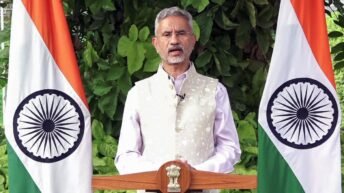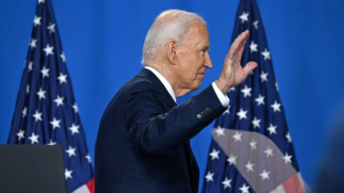|
Listen to article
Getting your Trinity Audio player ready...
|

Among the trinity of Hindu Gods, Brahma, Vishnu and Shiva, Vishnu is considered to be the sustainer and protector of the universe. According to Vaishnavism or Dvaita philosophy, Vishnu is the supreme soul, the genesis, the end, and the in-between. In the Vaishnava Puranas, the etymology of the word Vishnu has been derived from the prefix vish which means, to enter. This suggests Vishnu as the entering or pervading entity into the universe which has its roots in the Vedic texts.
Vishnu in the Holy Texts
Strangely, Vishnu hasn’t been mentioned often in the Vedas. In the Rigveda, he is mainly the Sun God, taking three steps across the world (Trivikrama), during the rise, mid-day and setting of the Sun. He is also associated with Indra and with Agni. In the Brahmana texts and the Upanishads one can easily observe the importance given to Vishnu since he is described as the sacrificial entity or Yagyapurusha.
During the Puranic period; possibly somewhere around 5th – 6th CE, we see the foundation of the well-defined Vishnu cult in India. Vishnu gained importance during this period; he was promoted as the Protector and Sustainer of the universe. The Puranas – Vishnu, Narada, Bhagavata, Garuda, Padma and Varaha – are the Vaishnava Puranas where we can find many stories associated with Vishnu and his various forms.
In the Vedic literature we see two phases of Vishnu; earlier as Aditya or Sun God and later as the sacrificial entity possessing the forms of Agni and Aditya altogether. The rise of Puranic literature helped in forming the strong and well defined Vaishnav cult where Vishnu gained so much importance that he was identified as the all-pervading Brahma or Parabrahma.
Iconographies of Vishnu across India
The early iconographic representations of Vishnu are from the Kushana period (1st to 3rd century CE) and majority of them are found in the area of Mathura which is even now a strong and living Vaishnava center. After the Kushanas, the Guptas officially promoted Vaishnavism and thus helped build many Vishnu temples. The basics of the Vishnu iconography for the later centuries were established in the Gupta period (3rd to 5th century CE).
A unique feature of Vaishnavism is the Avataravada or the incarnation theory. It probably began early and kept on developing until the 13th century or so. The famously known Vishnu Avataras are: Matsya, Kurma, Varaha, Narasimha, Vamana, Parashurama, Rama, Krishna, Buddha and Kalki. In some regions such as Kalinga and Southern India instead of Buddha, Balarama was names among the avatars. Apart from these incarnations, we also see Hari-Hara, Vishnu-Surya, Dhanvantari, Yoga-Narayana, Hayagriva, twenty-four forms such as Keshava, Madhava, Narayana, Govinda, etc. which are also considered as incarnations. Interestingly almost all these incarnations are represented in sculpture and paintings and well documented in ancient to medieval period texts on iconography and architecture.
In the early phases of depiction, we see an evolution from the Kushana Vishnu to the Gupta Vishnu. The Kushana Vishnu iconography featured Shankha, Chakra, Gada and Varada Hasta (boon-giving gesture) as the God’s attributes. This iconography underwent some modifications during the Gupta period when Gada, Shankha, Chakra and a Fruit. After the Gupta period we see a more artistic and composite image of Vishnu in which the fourth hand was replaced by a rosary bead or lotus among the permanent attributes. In early iconography, Vishnu was most probably shown as a singular figure or with his Vyuha incarnations such as Pradyumna, Aniruddha, Balarama, etc. but in the post-Gupta period he was always accompanied by his associates such as Lakshmi, Garuda and Sheshanaga. Thus, the definitive Vishnu iconography came into existence incorporating various elements attested in Vaishnavism since many centuries.
Chaturvyuha Vishnu, Kushan Period (Source: Mathura Museum)
Chaturvyuha Vishnu idol from Mathura museum which belongs to the Kushana period is regarded as the oldest example of Vishnu iconography. It has Vasudeva-Krishna as the central figure with Balarama, Aniruddha and Pradyumna (lost figure) emerging from it. The idol is however broken but it is considered as an important sculptural testimony to Vaishnavism and its expansion in its earlier phases.
Anantashayan Vishnu, Gupta Period, Deogarh, Madhya Pradesh (Source: Arnold Betten)
From the Gupta period we have the famous panels of the Vishnu temple at Deogarh, Uttar Pradesh. The Anantashayi Vishnu, Vishnu sleeping on Ananta snake, perhaps is the most spectacular sculpture from the Gupta period. In Deogarh, Vishnu is accompanied by Brahma, Indra, Lakshmi, Shiva-Parvati and Kartikeya.
Gajendra Moksha, Gupta Period, Deogarh, Madhya Pradesh (Source: Wikipedia)
Another spectacular panel from the same temple is the Gajendra-Moksha. In this panel, an elephant is depicted praying for help with a lotus flower wrapped in its trunk, while it is being strangled by the Nagas. Vishnu is shown flying on Garuda to liberate the elephant from its plight using his mighty Sudarshana Chakra.
Bhu-Varaha, Gupta Period, Vidisha, Madhya Pradesh (Source: Jean Peiree)
Again from the same period comes a beautiful and impressive Bhu-Varaha panel situated at Udayagiri caves in Vidisha, Madhya Pradesh where Varaha, the man-boar incarnation of Vishnu is depicted rescuing Goddess Earth (Bhudevi) from the depth of the cosmic ocean. In the background we observe various carved figurines consisting of sages, Shiva, Brahma, twelve Adityas, etc.
Anantashayi Vishnu, Mamallapuram, Tamil Nadu (Source: Purattatva.in)
In Southern India, during the Chalukya and Pallava periods (6th-7thcentury CE) some beautiful Vaishnava panels were carved at the site of Badami, Mamallapuram and Kanchipuram. Bhu-Varaha and Anantashayi panels at Mamallapuram caves are some of the praiseworthy bas-reliefs carved during that period. Among them the Anantashayi Vishnu is where the relaxed pose of Vishnu is depicted, with his right hand stretched out of the snake bed.
Legend of Narsimha, Vaikunth Perumal Temple, Kanchipuram (Source: Sriram MT)
The Vaikuntha Perumal Temple, Kanchipuram also contains many panels around the inner enclosure depicting the various stories of the Vaishnav Puranas.
Another important site is Badami, where the Chalukya sculptors crafted various Vaishnava images inside the caves. The famous Vaikuntha Vishnu and Trivikrama panels are among the most beautifully carved images seen in southern India. Trivikrama is being shown with multiple hands holding various attributes to evoke Virata-rupa or the magnificent form. Below one can see Vamana holding a small umbrella getting a boon for performing the three famous steps from King Mahabali.
Trivikrama, Badami, Karnataka (Source: Wikipedia)
The varied iconography of Vishnu from an early period illustrates the development and spread of Vaishnava sampradaya, its many branches and its influence all over the Indian subcontinent. It reflects religious texts as well as regional beliefs. Studying the evolution and local variations in the artistic representations of Vishnu will contribute significantly to our understanding of the evolution and dissemination of Hindu scriptures. The diversity of India in terms of art, culture, and regional beliefs is interestingly reflected in the Vaishnava iconography which is an important part of Indian art history.






Add comment